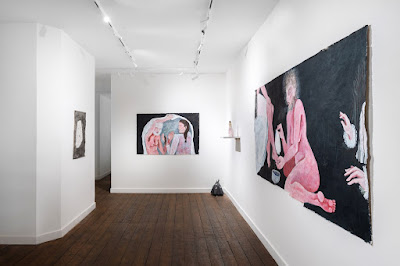[ Space ] Studios: Bread Show (until 15th December 2013)
Deep in Hackney, a borough becoming renowned for supporting up-and-coming contemporary art, lies Space Studios, E8, currently showing several exhibitions, including the group project of 'Bread Show', which is the main focus of the gallery. So-called 'new media' is something that is a constant source of experimentation for artists today, which Sophie Lee, Maxime Iten, Will Robinson and Robert Self have embraced as part of this collaborative project.
The exhibition space is large and blank, thus managing to illuminate the sculptural pieces. Now, let's cut to the chase here - the collection's title does not deceive its viewers; 'Bread Show' involves real baked items. Huge pieces of bread form universal gestures such as the two-fingered 'peace' sign, showing us the instability and lack of sustainability in art, especially installations. The fact that the sculpture material is supplied by Derek Carpenter and Bloomers Bakery gives a real intimate feel to the collection. However, exhibits with pleasant, inclusive interiors with a deeper foundation really make an effective visual, considerate experience.
The bread used in the project is an effective medium, as it is able to be carved and shaped to make the most intricate designs, which are also highly recognisable and relatable. The combination of the two aspects becomes a useful tool to enhance viewer experience and participation in an artist's work. Additionally, there is another dimension to 'Bread Show', as depicted by the exhibition's press release, with the pitch: "If we are what we eat, why not bake mantras and eat our words?" As such, the widely recognised gestures presented through the edible matter allow us to see the potential superficiality of actions around us; it could be seen as a parody of this.
The exhibition space is large and blank, thus managing to illuminate the sculptural pieces. Now, let's cut to the chase here - the collection's title does not deceive its viewers; 'Bread Show' involves real baked items. Huge pieces of bread form universal gestures such as the two-fingered 'peace' sign, showing us the instability and lack of sustainability in art, especially installations. The fact that the sculpture material is supplied by Derek Carpenter and Bloomers Bakery gives a real intimate feel to the collection. However, exhibits with pleasant, inclusive interiors with a deeper foundation really make an effective visual, considerate experience.
The bread used in the project is an effective medium, as it is able to be carved and shaped to make the most intricate designs, which are also highly recognisable and relatable. The combination of the two aspects becomes a useful tool to enhance viewer experience and participation in an artist's work. Additionally, there is another dimension to 'Bread Show', as depicted by the exhibition's press release, with the pitch: "If we are what we eat, why not bake mantras and eat our words?" As such, the widely recognised gestures presented through the edible matter allow us to see the potential superficiality of actions around us; it could be seen as a parody of this.
Photograph of [ Space ] Studios, taken by Let's Make Lots of Monet
Interestingly, the gallery also supplies its visitors with a written copy of a conversation between one of the show's artists, Sophie Lee, and a London-based chef who also practices art, Carlos Monleón Gendall. The two make some salient points about the exhibition, illuminating the cultural concept of sharing bread, bringing unity and company, something Lee describes as a 'drawing function'. They go on to confirm the ideas that the viewer can pick up, in regards to the 'social body', how our gestures and movements can often convey our ideas in equal measure to language, reinforcing the universality of the collection.
What is great about 'Bread Show' is the narrative that comes with the formation of the sculptures. Needless to say, using dough as a medium is unusual territory for art making, so incorporating Gendall in the interview allows the viewer to appreciate the practical element of the bread making, the 'bodily interaction with the dough'. It is always beneficial for an exhibition, especially regarding sculpture, to make time to show the artist's physical involvement with their pieces, as it can provide context and a certain intimacy between viewer, artist and resulting piece.
The exhibition is certainly a good investment of time, especially if the viewer happens to be an up-and-coming artist who wishes to experiment with media and new ideas, beyond the physically permanent. It is also suitable to other members of the public, as I believe different generations will have varying levels of understanding and appreciation for such innovative, intriguing methods.



